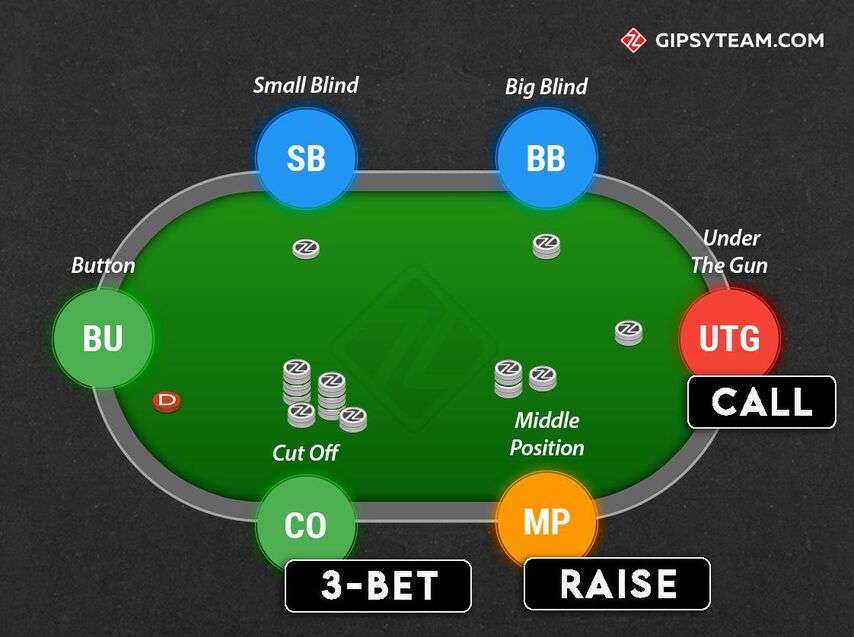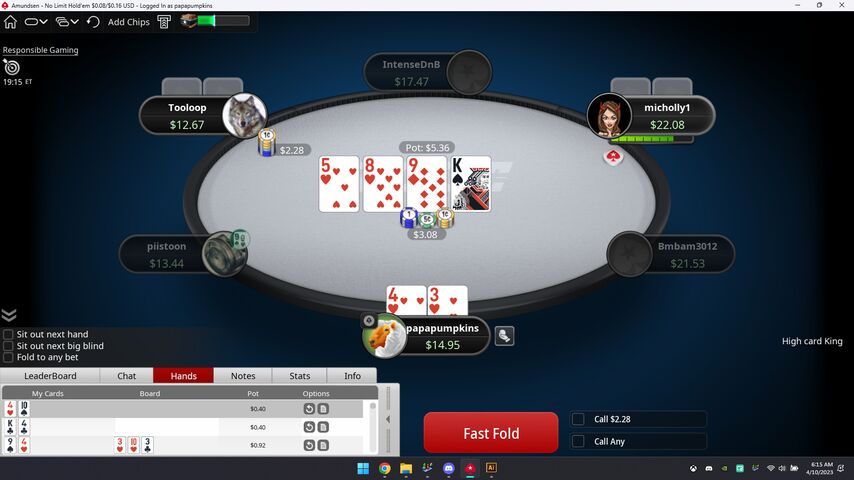The poker term “3-bet” refers to a raise that comes after an opponent’s raise. This kind of action typically happens more on tables full of experienced players and less on low and micro-stake tables. 3-bets can be used to build big pots or to pressure your opponents to fold better hole cards.
What is a 3-bet in poker? This is one of the terms you’ll hear often in the poker world, so let’s explain it. Imagine that a player makes a raise, instead of calling the big blind amount. If another player re-raises, that’s called a 3-bet. Take a look at this illustration for a quick example.

Some beginners may mistakenly think that a 3-bet is the third raise in a betting round of poker, but that’s not correct. A 3-bet is the first re-raise in a betting round of poker. The second re-raise is known as a 4-bet.
We’re going to talk about when to make 3-bets, when you should avoid 3-betting, and the importance of the position.
When To 3-Bet in Poker [And How Big To Make it]
In poker movies and the early days of the game, a 3-bet always indicated a premium hand. These days, things aren’t that simple. Here are a few of the reasons a poker player might decide to 3-bet:
The 3-Bet for Value: Build the pot when you have a strong poker hand. A well-timed 3-bet can maximize your profit when you have strong hole cards.
The 3-Bet Bluff: Opponents with better hands may fold from your pressure. Some of the players at the table could be too worried to continue if you choose the right size to re-raise (3-bet). You might be able to steal the pot right there, even if your opponent has better cards than you.
The Isolation 3-Bet: A 3-bet can reduce the number of opponents in the hand. More players in the hand can increase the pot size, but it can also decrease your chances of winning. Protect the strength of your hand by 3-betting, thinning the field, and reducing the number of opponents.
Now that you know a few reasons to 3-bet, how big should you size your re-raise?
The 3-bet size you choose will depend on the type of poker you’re playing (and the players). An acceptable size for an in-position 3-bet is around 2.5x to 3x the size of the first raise. When you’re playing out of position, increase the size slightly from 3.5x to 4x.

If you’re feeling like making some re-raises after reading this article, check out TigerGaming. This poker site attracts a lot of recreational players in Canada and America. They offer busy cash game tables, with Texas hold ‘em, Omaha, and short deck poker. They’re offering a huge matched deposit bonus right now, up to $1000 (minimum $10 deposit to qualify).
3-Bet Very Carefully In Some Situations
Players should always be cautious when 3-betting against opponents who have small stack sizes. If you 3-bet a player who doesn’t have many chips, prepare for a re-raise (4-bet).
This makes it a riskier strategy to 3-bet bluff with weaker hands. Let’s say you’ve been dealt a pair of 9s and you 3-bet an opponent. If they make a large 4-bet, are your pocket nines strong enough to continue?
3-betting against conservative, tight players can also get you into some trouble. Always consider who you are 3-betting and have a plan in case they make a 4-bet.
Recreational Players Aren’t 3-Betting Enough
Recreational online players at micro and low stake tables tend to 3-bet slightly smaller. On a site like PokerStars or America's Cardroom, a 3-bet can be super profitable against low-stakes players if it’s applied correctly.

You’ll notice small-stakes players 3-betting almost entirely with premium hands. Only 3-betting when you are strong is far too transparent and opponents will quickly take advantage of it.
You can exploit this kind of tight, conservative play, by 3-betting with some non-premium hands. You’ll be much trickier for opponents to play against and they’ll have to make some difficult decisions.
You’ll often see much more strategic 3-betting and 4-betting as the stakes increase.
3-Betting Out of Position and In Position
A player’s position is ultra-important in poker. There’s an informational advantage for players who act last in betting rounds since they get to see everyone’s actions before making their decision.
3-Betting Strategy In Position: You can play a wider range of hands if you choose to 3-bet in position. Include premium hands, balanced with less premium holdings like suited connectors and lower pocket pairs. Whicher hands you decide to 3-bet with, be sure to have a plan ready.
Commonly, opponents will defensively check after calling a 3-bet, giving control of the action to the 3-better.
3-Betting Strategy Out of Position: When you play poker out of position, you are forced to act first. For this reason, tighten your range and play stronger hands than you would if you were 3-betting in position. It’s also better to increase the size of an out-of-position 3-bet.
But why? Aren’t we giving our opponent (who’s in position) more chips to potentially win?
The reason that you should size up your 3-bets when playing out of position is that it forces opponents to play more predictable ranges.
For example, you’re dealt a hand like pocket kings in the big blind position. There has already been a raise by another player, so you’re just thinking about the size of your 3-bet.
- If you size the 3-bet too small, your opponent can call with a wide range of hands and play against you with a positional advantage.
- If you make the 3-bet size larger, your opponent is pressured to fold speculative hands and play a much smaller range of hands. With a smaller range, you’ll have an easier time playing against them out of position.
- GipsyTeam's unique promotions
- Help with deposits and cashouts
- Access to private freerolls
- Round-the-clock support
- GipsyTeam's unique promotions
- Help with deposits and cashouts
- Access to private freerolls
- Round-the-clock support
- GipsyTeam's unique promotions
- Help with deposits and cashouts
- Access to private freerolls
- Round-the-clock support
- Уникальные акции от GipsyTeam
- Помощь с депозитами и кешаутами
- Доступ в закрытые фрироллы
- Круглосуточная поддержка
- Уникальные акции от GipsyTeam
- Помощь с депозитами и кешаутами
- Доступ в закрытые фрироллы
- Круглосуточная поддержка
- GipsyTeam's unique promotions
- Help with deposits and cashouts
- Access to private freerolls
- Round-the-clock support
- Уникальные акции от GipsyTeam
- Помощь с депозитами и кешаутами
- Доступ в закрытые фрироллы
- Круглосуточная поддержка
- GipsyTeam's unique promotions
- Help with deposits and cashouts
- Access to private freerolls
- Round-the-clock support
- GipsyTeam's unique promotions
- Help with deposits and cashouts
- Access to private freerolls
- Round-the-clock support
- GipsyTeam's unique promotions
- Help with deposits and cashouts
- Access to private freerolls
- Round-the-clock support
- GipsyTeam's unique promotions
- Help with deposits and cashouts
- Access to private freerolls
- Round-the-clock support
- GipsyTeam's unique promotions
- Help with deposits and cashouts
- Access to private freerolls
- Round-the-clock support
- GipsyTeam's unique promotions
- Help with deposits and cashouts
- Access to private freerolls
- Round-the-clock support
- GipsyTeam's unique promotions
- Help with deposits and cashouts
- Access to private freerolls
- Round-the-clock support
- GipsyTeam's unique promotions
- Help with deposits and cashouts
- Access to private freerolls
- Round-the-clock support
- GipsyTeam's unique promotions
- Help with deposits and cashouts
- Access to private freerolls
- Round-the-clock support
- GipsyTeam's unique promotions
- Help with deposits and cashouts
- Access to private freerolls
- Round-the-clock support
- GipsyTeam's unique promotions
- Help with deposits and cashouts
- Access to private freerolls
- Round-the-clock support
- GipsyTeam's unique promotions
- Help with deposits and cashouts
- Access to private freerolls
- Round-the-clock support
- GipsyTeam's unique promotions
- Help with deposits and cashouts
- Access to private freerolls
- Round-the-clock support
- GipsyTeam's unique promotions
- Help with deposits and cashouts
- Access to private freerolls
- Round-the-clock support
- GipsyTeam's unique promotions
- Help with deposits and cashouts
- Access to private freerolls
- Round-the-clock support
- Уникальные акции от GipsyTeam
- Помощь с депозитами и кешаутами
- Доступ в закрытые фрироллы
- Круглосуточная поддержка
- GipsyTeam's unique promotions
- Help with deposits and cashouts
- Access to private freerolls
- Round-the-clock support
- GipsyTeam's unique promotions
- Help with deposits and cashouts
- Access to private freerolls
- Round-the-clock support
- GipsyTeam's unique promotions
- Help with deposits and cashouts
- Access to private freerolls
- Round-the-clock support
- GipsyTeam's unique promotions
- Help with deposits and cashouts
- Access to private freerolls
- Round-the-clock support
- GipsyTeam's unique promotions
- Help with deposits and cashouts
- Access to private freerolls
- Round-the-clock support
- GipsyTeam's unique promotions
- Help with deposits and cashouts
- Access to private freerolls
- Round-the-clock support
- Уникальные акции от GipsyTeam
- Помощь с депозитами и кешаутами
- Доступ в закрытые фрироллы
- Круглосуточная поддержка
- GipsyTeam's unique promotions
- Help with deposits and cashouts
- Access to private freerolls
- Round-the-clock support
- GipsyTeam's unique promotions
- Help with deposits and cashouts
- Access to private freerolls
- Round-the-clock support
- Уникальные акции от GipsyTeam
- Помощь с депозитами и кешаутами
- Доступ в закрытые фрироллы
- Круглосуточная поддержка
- GipsyTeam's unique promotions
- Help with deposits and cashouts
- Access to private freerolls
- Round-the-clock support
- Уникальные акции от GipsyTeam
- Помощь с депозитами и кешаутами
- Доступ в закрытые фрироллы
- Круглосуточная поддержка
- Уникальные акции от GipsyTeam
- Помощь с депозитами и кешаутами
- Доступ в закрытые фрироллы
- Круглосуточная поддержка
- GipsyTeam's unique promotions
- Help with deposits and cashouts
- Access to private freerolls
- Round-the-clock support
- GipsyTeam's unique promotions
- Help with deposits and cashouts
- Access to private freerolls
- Round-the-clock support
- GipsyTeam's unique promotions
- Help with deposits and cashouts
- Access to private freerolls
- Round-the-clock support
- Уникальные акции от GipsyTeam
- Помощь с депозитами и кешаутами
- Доступ в закрытые фрироллы
- Круглосуточная поддержка
- GipsyTeam's unique promotions
- Help with deposits and cashouts
- Access to private freerolls
- Round-the-clock support
- GipsyTeam's unique promotions
- Help with deposits and cashouts
- Access to private freerolls
- Round-the-clock support
- GipsyTeam's unique promotions
- Help with deposits and cashouts
- Access to private freerolls
- Round-the-clock support
- GipsyTeam's unique promotions
- Help with deposits and cashouts
- Access to private freerolls
- Round-the-clock support
- Уникальные акции от GipsyTeam
- Помощь с депозитами и кешаутами
- Доступ в закрытые фрироллы
- Круглосуточная поддержка
- GipsyTeam's unique promotions
- Help with deposits and cashouts
- Access to private freerolls
- Round-the-clock support
- GipsyTeam's unique promotions
- Help with deposits and cashouts
- Access to private freerolls
- Round-the-clock support


















